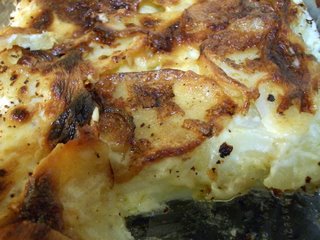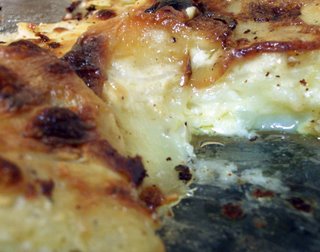Potato Gratin
I haven’t made this since last winter, so the urge to do it confirms that we are inching inexorably closer to cooler temperatures. Yay to that.
 I always feel as though potatoes need help. On their own they’re a bit boring unless they’ve been turned into a chip or roasted in duck fat (but see – that’s helping too). Boiled, baked … blah. Salad? Only if they’re supporting something interesting. Mash? Only if it’s colcannon or champ. Röesti? Getting warmer. The French do things to potatoes that take all afternoon with a 9.5 degree of difficulty just for a support act, but this one’s much less stressful, and quick and easy given the impressive nature of the outcome. The oo-ahh factor from guests is high. Almost as high as the number of calories. This recipe is not, according to Larousse, the classic Gratin de Pommes de Terre à la Dauphinoise, which has cheese and eggs and stuff in it, and indeed there are many different recipes for potato gratin which have lots of cheese, cabbage, and vegetables and other things. But this is my favourite, a version adapted from Stephanie Alexander.
I always feel as though potatoes need help. On their own they’re a bit boring unless they’ve been turned into a chip or roasted in duck fat (but see – that’s helping too). Boiled, baked … blah. Salad? Only if they’re supporting something interesting. Mash? Only if it’s colcannon or champ. Röesti? Getting warmer. The French do things to potatoes that take all afternoon with a 9.5 degree of difficulty just for a support act, but this one’s much less stressful, and quick and easy given the impressive nature of the outcome. The oo-ahh factor from guests is high. Almost as high as the number of calories. This recipe is not, according to Larousse, the classic Gratin de Pommes de Terre à la Dauphinoise, which has cheese and eggs and stuff in it, and indeed there are many different recipes for potato gratin which have lots of cheese, cabbage, and vegetables and other things. But this is my favourite, a version adapted from Stephanie Alexander.2-3 large potatoes (about 600-700 grams total) – I use an all purpose variety like Sebago which has a balance of waxy/starchy qualities.
Butter for greasing
½ an onion finely sliced, separate the slices into half-moon slivers
1 clove of garlic, finely sliced
Nutmeg to grate fresh
300 mls of milk
300 mls of cream (I prefer single pouring cream for this recipe)
1 teaspoon of plain flour
Salt and pepper.
 Peel and slice the potatoes thinly. Not mandolin-thin or they’ll collapse, but about 2 millimetres. Grease a baking dish with butter. Don’t use oil. Layer the potatoes in the dish with a few of the onion and garlic slivers, adding fresh grated nutmeg, salt and pepper to each layer as you go. Add the spoonful of flour to a little of the cream and work out the lumps, then add the rest of the cream and milk and mix thoroughly.
Peel and slice the potatoes thinly. Not mandolin-thin or they’ll collapse, but about 2 millimetres. Grease a baking dish with butter. Don’t use oil. Layer the potatoes in the dish with a few of the onion and garlic slivers, adding fresh grated nutmeg, salt and pepper to each layer as you go. Add the spoonful of flour to a little of the cream and work out the lumps, then add the rest of the cream and milk and mix thoroughly.A little note here, and it’s back to first year Uni Chemistry lectures which I always thought were a complete waste of time, but it seems now are actually of some use. You must use cream and full fat cream at that. Don’t be tempted to use just milk. Why? Potatoes are acidic. When you put acid with milk, especially under heat, it can curdle unless the butterfat content is over 25%. If you encounter a gratin that’s developed that split cheese look, that’s possibly what’s happened. The little bit of flour helps to prevent this too. You can use all cream if you like, but don’t send your cardiologist’s bill to me.
Pour this mixture over the potatoes so that the liquid is just below the level of the potatoes. You should also try to have at least a few centimetres or so of baking dish rising above the level of potatoes, unless you particularly enjoy cleaning burnt cream off the bottom of your oven. If you find you’re a bit light on liquid, add some more milk and cream, as the actual volume you need will somewhat depend on the size and shape of your dish.
 Put into a pre-heated 180°C oven for about an hour. Several things will happen. The liquid will bubble up and boil quite vigorously over the potatoes. That’s fine, it will eventually thicken and bubble less as it is absorbed into the spuds. After about 30-40 minutes, the potatoes will collapse slightly at which point I push them down lightly, sinking them back into the cream with a flat spatula. I find this helps give a very even crust. At the end of the cooking time, ensure you have a dark brown crust on top, remove form the oven, and let it stand for 5-10 minutes, as it’s easier to slice and slightly firmer.
Put into a pre-heated 180°C oven for about an hour. Several things will happen. The liquid will bubble up and boil quite vigorously over the potatoes. That’s fine, it will eventually thicken and bubble less as it is absorbed into the spuds. After about 30-40 minutes, the potatoes will collapse slightly at which point I push them down lightly, sinking them back into the cream with a flat spatula. I find this helps give a very even crust. At the end of the cooking time, ensure you have a dark brown crust on top, remove form the oven, and let it stand for 5-10 minutes, as it’s easier to slice and slightly firmer.You will end up with an alchemically transformed potato which has subtly absorbed the flavours of onion, garlic and nutmeg, and is silky smooth while being still slightly biteable, rather than mushy. Serve it with anything, at the table, and drink in the ooo’s and aaaaaah’s.





3 Comments:
And that crust is so important too, good tip. Amazing how you worked your first year uni chemical lecture into a fod blog, nicely done. I've heard Rick Stein say he thought the garlic caused the dairy to split, but your reasoning makes more sense, but he did go on to say this was desirable. Our version made with half cream and half milk, and the other one made with all single cream always seem to split. Maybe that's where the egg and cheese comes in.
The other thing I've read is that sometimes cooking it at too high a temp can split it, which is why I go for 180C rather than 200C or above. And I reckon cheese as well just puts the cholesterol-o-meter over the edge!
I had it at my grandmas when i was a kid and it was delicious ever since then ive had it at least once a week un till i became allergic to it last saturday i hate to think of not being able to have it especially when i cook it for my kids and they love it to.
Post a Comment
<< Home